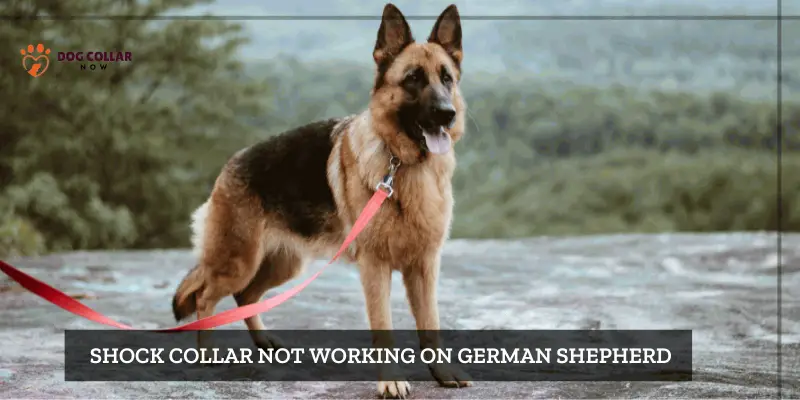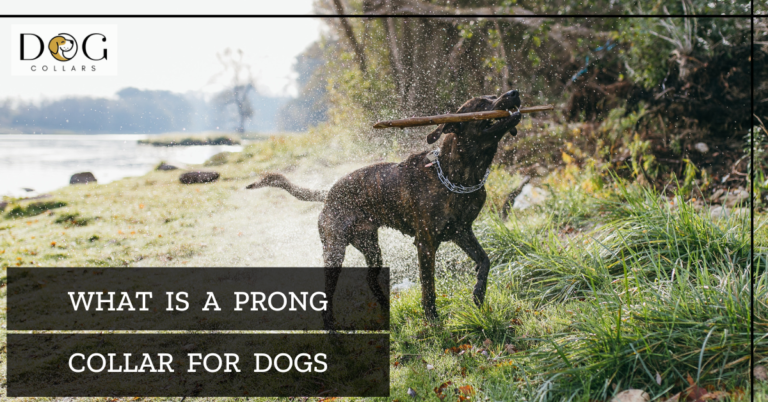Shock Collar Not Working On German Shepherd – Troubleshooting

German Shepherds have a high pain tolerance and strong-willed nature, which can make shock collars less effective as a training tool for them. But alas! Despite your best efforts, it seems like that shock collar is nothing more than a fancy accessory on your pup’s neck.
Don’t distress! You’re not alone in this training dilemma. Many German Shepherd owners have experienced similar frustrations when trying to utilize shock collars as a training tool.
A malfunctioning shock collar can result from various factors like low battery, improper fit, signal interference, or individual sensitivity, so troubleshooting to find the right solution.
Get ready to uncover the secrets behind why that shock collar not working on German Shepherd and discover effective strategies to transform your mischievous pup into a well-behaved companion! Let’s embark on this exciting journey together, shall we?
Why the Shock Collar isn’t Working On German Shephard – Possible Reasons
There can be several reasons why the shock collar isn’t working as expected on your German Shepherd.
1. Inadequate Training
One possible reason why the shock collar may not be effective on your German Shepherd is inadequate training. It’s important to remember that a shock collar should never be used as a standalone training tool, but rather as part of a comprehensive training program.
If you haven’t properly trained your dog in basic commands and behaviors, they may not understand what the shocks are intended to communicate.
2. Insufficient Intensity
Likewise, the reason could be that the stimulation level of the shocks is too low and there is only vibration, not a shock. Every dog is different, and some breeds require higher levels of stimulation to respond effectively.
It’s essential to adjust the intensity based on your dog’s individual needs and temperament. The accumulation of hair under the contact points can disrupt conductivity, leading to inconsistent responses from the shock collar.
3. Lack of Consistency
Consistency is key when using a shock collar, including another training method. If you are inconsistent with applying corrections or fail to reinforce desired behaviors consistently, it can confuse your dog and render the shock collar less effective.
4. Environmental Distractions
Environmental factors such as noise, other animals, or unfamiliar surroundings can distract your German Shepherd from responding to the shocks appropriately. Ensure that you’re using the collar in a controlled environment initially before introducing more distractions gradually.
4. Environmental Distractions
Some dogs may have underlying medical issues or sensitivities that make them less responsive to electric stimulations from shock collars. Before relying solely on this type of training tool, it’s crucial to rule out any health concerns with a veterinarian.
Remember that every dog is unique and may respond differently even within their breed characteristics! It’s important always to consider alternative methods if necessary and seek professional help when needed!
Things to Try If the Shock Collar isn’t Working
When it comes to training your German Shepherd, using an e-collar can be an effective tool. However, there may come a time when you find that the dog collar isn’t working as expected. Before giving up on this training method, there are a few things you can try.
- Check the settings on the remote collar. Make sure it is properly adjusted and set at an appropriate level for your dog’s size and temperament.
- Sometimes, simply increasing or decreasing the intensity can make a difference in how your pet responds.
- If the shock collar seems a bit too snug on your pup, give it some breathing room by loosening it up a bit! A comfortable collar means happy training and maximum effectiveness!
- Consider whether there might be any distractions in the environment that are causing your dog to ignore the shocks.
- Another factor to consider is consistency and timing. Are you consistently using the shock collar during training sessions? Are you delivering corrections immediately after undesirable behavior occurs? Dogs rely on consistency and immediate feedback to understand what behaviors are unacceptable.
- Take into account that every dog is unique and may respond differently to various training methods.
- In some cases, alternative training techniques like positive reinforcement or clicker training may work better for your German Shepherd than relying solely on a shock collar.
Remember that patience is key when it comes to dog training. It takes time for dogs to learn new behaviors and adjust their responses accordingly. If after trying these suggestions you still find that the shock collar isn’t effective, it might be worth seeking professional help from a qualified dog trainer who specializes in behavioral issues.
When to Seek Professional Help
If you’ve tried various methods and the shock collar still isn’t working for your GS, it may be time to consider seeking professional help. While it’s common for dog owners to want to handle training themselves, sometimes expert guidance is necessary.
A qualified dog trainer or behaviorist can assess your specific situation and provide customized training techniques that are better suited to your German Shepherd’s needs. They have a wealth of knowledge and experience in dealing with different types of dogs and behavioral issues.
Professional trainers can also identify underlying factors that may be contributing to the collar’s ineffectiveness, such as fear or anxiety. They have the skills to address these issues and develop a comprehensive training plan tailored specifically for your dog.
The debate continues, but many experts and dog owners believe that shock collars can have negative effects on German Shepherds, potentially impacting their well-being and trust in their owners.
Remember, asking for assistance doesn’t mean you’ve failed as an owner; rather, it shows dedication toward finding the best solution for your dog. So don’t hesitate to reach out if you feel overwhelmed or stuck in your training efforts – professionals are there precisely to assist in situations like this!
By taking this step, you increase the chances of successfully resolving any behavior problems with the help of an expert who understands both dogs and their unique personalities.
How To Train A German Shepherd With A Shock Collar
Using a shock collar to train your German Shepherd can be effective when done correctly. However, it’s essential to approach this method with care and consideration for your dog’s well-being. Here are some useful tips and guidelines to ensure safe and successful training:
Choose The Right Collar:
- Opt for high-quality e-collars with adjustable settings and a reliable safety mechanism.
- Ensure the collar fits snugly but not too tightly around your dog’s neck. You should be able to fit two fingers between the collar and your dog’s skin.
- The stubborn collar mark on your dog’s neck requires a little TLC and finding the perfect-fitting collar!
Introduce the Collar Gradually:
- Allow your German Shepherd to become familiar with the shock collar before starting any training. Let them sniff and explore it while associating it with positive experiences, like treats and praise.
Seek Professional Guidance:
- If you’re new to using a shock collar, consider consulting a professional dog trainer with experience in this method.
- A trainer can guide you on using the correct intensity levels and help you avoid common mistakes.
Understand Correct Timing and Corrections:
- Use the shock collar as a corrective measure rather than a punishment tool.
- Timely corrections help your GS associate their actions with consequences, enhancing their learning process.
Start with Low Settings:
- Begin with the lowest shock intensity setting and observe your dog’s reaction.
- Gradually increase the intensity only if necessary, and always use the lowest effective level for training.
Combine Positive Reinforcement:
- Supplement shock collar training with positive reinforcement, such as treats, verbal praise, or toys.
- Reward your GS when they display the desired behavior, reinforcing positive associations.
Keep Training Sessions Short and Positive:
- Keep training sessions brief and engaging to maintain your dog’s focus and enthusiasm.
- End each session on a positive note to leave your dog feeling accomplished.
Be Consistent and Patient:
- Consistency is key to successful training. Use the same commands and rules consistently to avoid confusion.
- Be patient with your dog; learning takes time, and positive results may not happen overnight.
Monitor Your Dog’s Reactions:
- Continuously monitor your dog’s behavior and reactions during training.
- If you notice signs of distress or discomfort, reassess your training approach and consider alternative methods.
Training your GS with a shock collar can be effective, but it requires responsibility and understanding. Remember, the shock collar should be a tool for reinforcement rather than punishment. Combine it with positive reinforcement and always prioritize your dog’s well-being. With patience, consistency, and proper guidance, you can build a strong bond with your German Shepherd while achieving successful training results.
Conclusion
In conclusion, if you find that the shock collar is not yielding the desired results in training your German Shepherd, it’s crucial to consider alternative methods like prong collar training. Remember, each dog is unique, and a one-size-fits-all approach may not be effective. Prioritize your dog’s well-being and explore effective training techniques while also seeking guidance from a professional trainer if needed. Building a strong bond with your dog through trust and understanding will lead to more successful and humane training, without relying solely on a shock collar. Always ensure your dog’s comfort and happiness during the training process.
FAQs
Did you check to make sure both the transmitter and receiver are turned on?
Yes, ensure both the transmitter and receiver are turned on.
Why isn’t my dog responding to the shock collar?
Check the fit, settings, and consider alternative training methods like positive reinforcement.
What do you do when your shock collar doesn’t work?
Troubleshoot the collar, seek professional guidance, and explore different training approaches.
Do vets hate shock collars?
Views vary, but some vets express concerns about potential risks and prefer alternative training methods.
How do I get my dog to listen with a shock collar?
Use consistent commands, combine positive reinforcement, and ensure proper collar usage for effective training.






